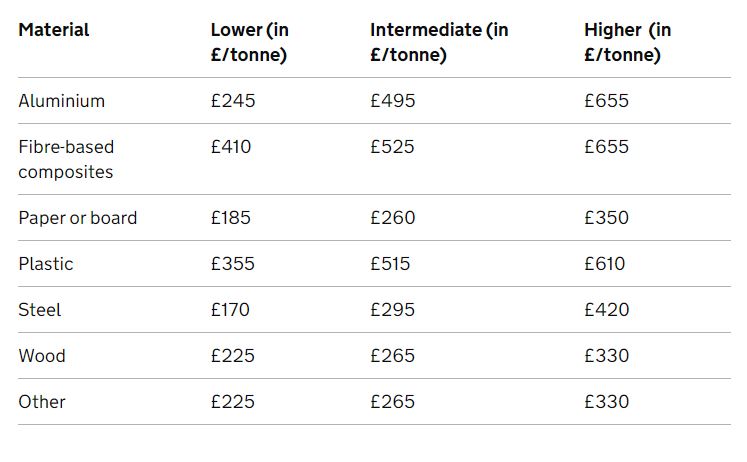16 Aug. 2024: Defra (Department for Environment, Food and Rural Affairs) has published details of initial (indicative) extended producer responsibility (EPR) packaging base fees for the UK beginning in 2025.
The document published yesterday provides information on initial illustrative base fees for year 1 of EPR for packaging. It relates to fees that would be charged to obligated packaging producers by the Scheme Administrator (SA).
The illustrative base fees announced for eight packaging categories respond to the industry’s demands for clarity on upcoming costs.
Revenue from the fees will reportedly generate more than £1 billion (US$1.3 billion) annually to support local collection and disposal services, including recycling services — benefiting UK households.
Predicting business costs
Defra said this would also create investment opportunities across the UK’s recycling infrastructure, supporting economic growth and alongside wider packaging reforms helping to unlock the sector’s commitment to invest £10 billion (US$12.8 billion) in new recycling infrastructure during the next decade.
Robbie Staniforth, head of Policy at Ecosurety, tells us that the release of information is another significant milestone on the road to EPR implementation.
Throwing empty aluminum cans in bin.Defra says the EPR fees create investment opportunities across the UK’s recycling infrastructure.“Given the remaining cost uncertainty of the new system, it is understandable that the government has given a range of expected costs. These indicative fees will allow packaging producers to start the complicated process of agreeing internal budgets for these new costs in 2025.”
“Approaches for how they use these indicative figures will vary, depending on each individual company’s budget setting process. We are pleased to see that the figures are similar to the predictions we have been supplying members for the last few years using our industry-leading tool,” adds Staniforth.
Meanwhile, Jim Bligh, director of Corporate Affairs and Packaging at The Food and Drink Federation, says that food and drink manufacturers support the government’s zero waste goal and are committed to a cleaner environment.
“We welcome the long-awaited release of base fees for EPR, which helps manufacturers take more responsibility for packaging and helps them plan for 2025 costs. With EPR expected to cost at least £1.4 billion [US$ billion] in 2025, it’s crucial that funds are used to improve recycling infrastructure,” Bligh tells Packaging Insights.
Material fees
Fees will be incurred from April 1 each year, based on packaging supplied by registered producers for the preceding calendar year. The deadline for reporting data on RPD is April 1. As a result, fee rates for the first year of EPR for packaging (2025/26) won’t be known until after April 1, 2025.
From year 2 of EPR, fees will be modulated to ensure packaging materials that have a lower environmental impact will be the least expensive for producers to use. By introducing a modulated fee structure into the market, the use of unsustainable packaging materials will decrease, serving to reduce waste going to landfills and reduce CO2 emissions.
Allowing for relevant checks to be carried out and billing approvals to be obtained, it is expected that the SA will issue invoices in early summer each year. Invoicing in the first year of EPR for packaging may operate to a different timetable because the SA may still be in the process of being formally established.
The illustrative fees have been calculated using different datasets from those the SA will use to calculate actual fees. Defra explains the fee has been calculated using weights of household packaging placed on the market in 2022, taken from the “PackFlow Refresh 2023” reports.
The fees in Table 1 include estimations of Local Authority (LA) packaging waste management costs by the Waste & Resources Action Programme (WRAP). Illustrative base fees are being provided separately for glass (Table 2), as these were estimated using a separate methodology to ascertain LA costs being developed by Defra, which will be used to calculate the final EPR for packaging base fees.


Further data needed
Defra says the methodology is still under development and, therefore, has not been applied across all materials, but it was used for glass because it is considered to be more robust for this specific material.
These illustrative fees are Defra’s first estimate — based on available evidence — and are not final fees.
“The government recognizes that obligated producers may wish to use the higher or lower estimates to assess worst and best case scenarios. This is not recommended. While these illustrative base fees can help the industry with early preparedness, these figures are still subject to significant uncertainty and will change in the future,” comments Defra.
“Given the significant data limitations, the government intends to publish refined figures for the illustrative base fees in September 2024, once the data received via the government’s RPD online portal has been further reviewed and evaluated. Illustrative fees are also subject to the 2024 spending review.”
Defra says the robustness of this data and the size of the range will be dependent on sufficient, high quality, producer data being submitted on time. The next deadline for reporting six months of 2024 household packaging data is October 1, 2024.
“Everyone must work together to ensure EPR drives value, boosts recycling rates and fosters a circular economy. Defra should now empower producers to manage the scheme, encouraging investment, green jobs and innovation in packaging,” concludes Bligh.
By Natalie Schwertheim https://www.packaginginsights.com/
